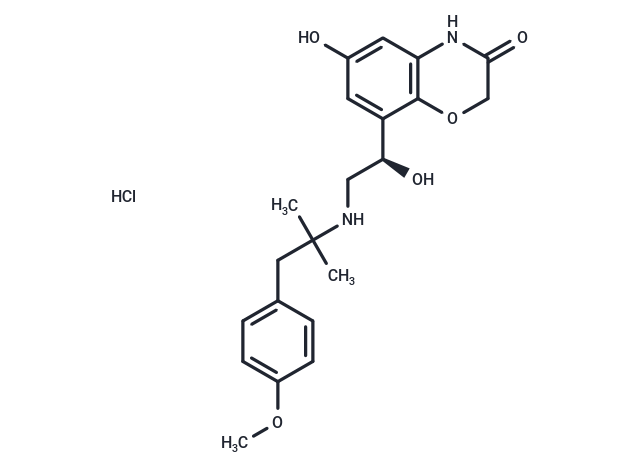Shopping Cart
- Remove All
 Your shopping cart is currently empty
Your shopping cart is currently empty
Olodaterol hydrochloride (BI-1744 HCl) is a novel, long-acting β2-adrenergic agonist (EC50s: 97.7 nM for the human β2-adrenoceptor) that exerts its pharmacological effect by binding and activating β2-adrenergic receptors.

| Pack Size | Price | Availability | Quantity |
|---|---|---|---|
| 1 mg | $56 | In Stock | |
| 2 mg | $79 | In Stock | |
| 5 mg | $122 | In Stock | |
| 10 mg | $198 | In Stock | |
| 25 mg | $369 | In Stock | |
| 50 mg | $549 | In Stock | |
| 100 mg | $788 | In Stock |
| Description | Olodaterol hydrochloride (BI-1744 HCl) is a novel, long-acting β2-adrenergic agonist (EC50s: 97.7 nM for the human β2-adrenoceptor) that exerts its pharmacological effect by binding and activating β2-adrenergic receptors. |
| Targets&IC50 | β2-adrenoceptor (human):97.7 nM(EC50) |
| Synonyms | BI-1744 HCl, BI 1744 hydrochloride |
| Molecular Weight | 422.9 |
| Formula | C21H27ClN2O5 |
| Cas No. | 869477-96-3 |
| Smiles | Cl.COc1ccc(CC(C)(C)NC[C@H](O)c2cc(O)cc3NC(=O)COc23)cc1 |
| Relative Density. | no data available |
| Storage | Pure form: -20°C for 3 years | In solvent: -80°C for 1 year | Shipping with blue ice/Shipping at ambient temperature. | ||||||||||||||||||||||||||||||||||||||||
| Solubility Information | DMSO: 60 mg/mL (141.88 mM), Sonication is recommended. H2O: 15 mg/mL (35.47 mM), Sonication is recommended. | ||||||||||||||||||||||||||||||||||||||||
Solution Preparation Table | |||||||||||||||||||||||||||||||||||||||||
H2O/DMSO
DMSO
| |||||||||||||||||||||||||||||||||||||||||

Copyright © 2015-2025 TargetMol Chemicals Inc. All Rights Reserved.